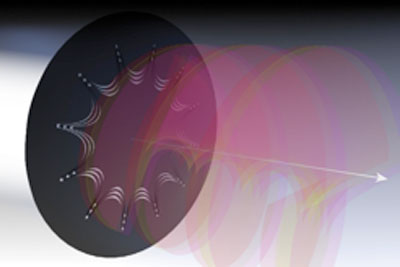| Posted: Oct 02, 2015 | |
Optical nanostructures inspired by architecture |
|
| (Nanowerk Spotlight) The orbital angular momentum (OAM) carried by the optical vortex is very intriguing but difficult to control using naturally occurring materials. In an article published today (Oct. 2) in Science Advances ("Catenary optics for achromatic generation of perfect optical angular momentum"), Prof. Xiangang Luo from the Chinese Academy of Sciences and co-workers have now demonstrated that perfect OAM could be generated in optical nanostructures inspired by catenaries. | |
| A catenary is the curve that a free-hanging chain assumes under its own weight. It is a 'true mathematical and mechanical form' in architecture described by Robert Hooke in the 1670s. | |
| Catenaries are used in in architecture and engineering, for instance in the design of bridges and arches. Famous catenaries can be found in the arches under the roof of Gaudí’s Casa Milà, Barcelona, and the Gateway Arch in St. Louis, Missouri. | |
| The research team used optical catenary-shaped structures to convert circularly polarized light to helically-phased beam carrying OAM. Similar to the 'catenary of equal strength', the phase gradient of the optical catenary is equal everywhere, which is a direct result of its special geometric shape. | |
| "The catenary structure could find applications in optics, architectures, and many other disciplines," Prof. Luo explains. "This means that we could construct novel optical devices with strong similarity to the structures occurring in the natural world." | |
 |
|
| An illustration of optical catenaries for OAM generation. An incident light beam on the catenary structures results in orbital angular momenta transferred from the structure to photons. This process is independent of the wavelength. (Image: SKLOTNM, Chinese Academy of Science) | |
| Achromatic phase shift | |
| The key of OAM generation is to shape the phase front to become helical. Previous methods used discrete nanostructures to generate OAM. The discrete structures lead to strong resonance, which makes the operating bandwidth of these samples limited. | |
| Prof. Luo’s group at the State Key Laboratory of Optical Technologies on Nano-fabrication and Micro-engineering (SKLOTNM) therefore used the continuous catenary structures to obtain much broader bandwidth. | |
| The operating bandwidth of catenary structures could cover the entire electromagnetic spectrum ranging from microwave, terahertz, and infrared to the visible regime. | |
| The phase shift properties of the catenaries have additional applications in planar optical systems. Besides the OAM generation, catenaries could be used as a unique building block for optical metasurfaces. | |
| According to the metasurface-assisted law of reflection and refraction, many novel optical elements, such as flat lenses, axicons, and prisms, could be obtained with performance far beyond their traditional counterparts. | |
| "The method of using catenary nanostructures to modulate phase works in many different circumstances," notes Luo. "On the one hand, these nanostructures are natural candidates for the light manipulation on the nanoscale. On the other hand, when these structures are fabricated on flexible substrate, very lightweight and large-aperture lens could be realized. Such lenses make very large space telescopes become possible." | |
|
By Mingbo Pu, Institute of Optics and Electronics, Chinese Academy of Sciences
|
|
|
Become a Spotlight guest author! Join our large and growing group of guest contributors. Have you just published a scientific paper or have other exciting developments to share with the nanotechnology community? Here is how to publish on nanowerk.com. |
|
